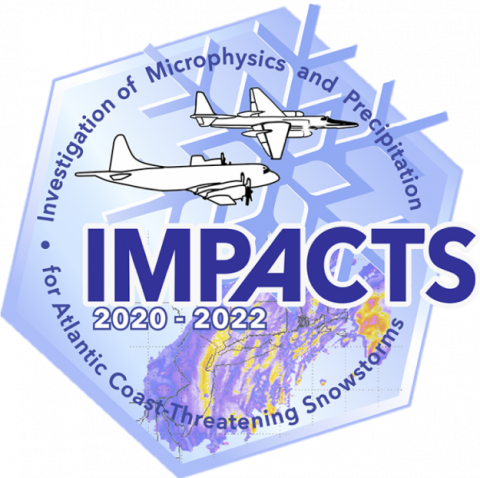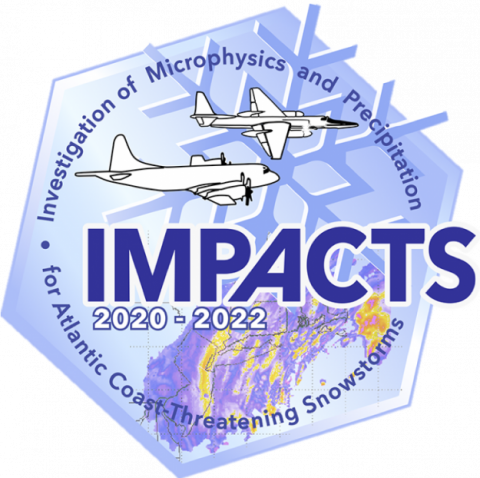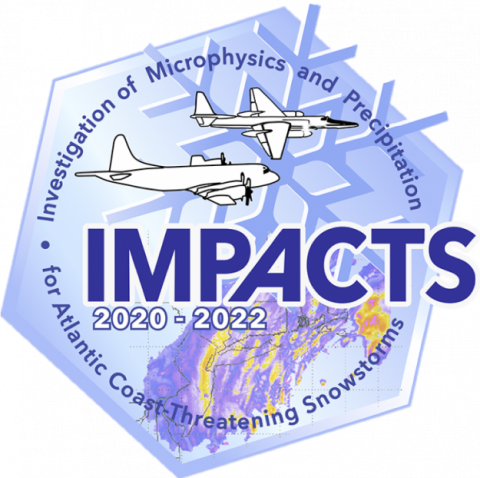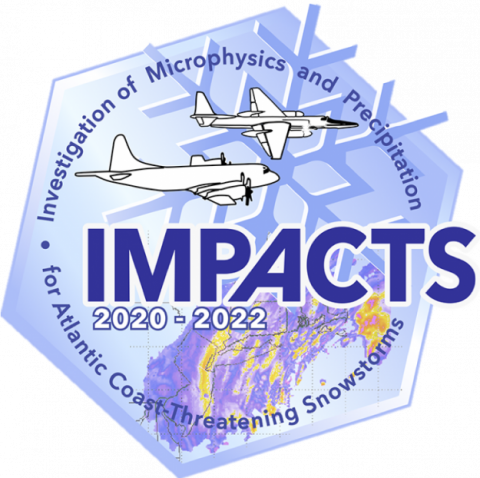 The NASA Global Hydrology Resource Center (GHRC) DAAC published the SBU Micro Rain Radar 2 (MRR-2) IMPACTS dataset. This dataset consists of reflectivity, Doppler velocity, signal-to-noise ratio, spectral width, droplet size, Liquid Water Content, melting layer, drop size distribution, rain attenuation, rain rate, and radial velocity data collected during the Investigation of Microphysics and Precipitation for Atlantic Coast-Threatening Snowstorms (IMPACTS) field campaign. IMPACTS was a three-year sequence of winter season deployments conducted to study snowstorms over the U.S. Atlantic Coast (2020-2022). The campaign aimed to (1) Provide observations critical to understanding the mechanisms of snowband formation, organization, and evolution; (2) Examine how the microphysical characteristics and likely growth mechanisms of snow particles vary across snowbands; and (3) Improve snowfall remote sensing interpretation and modeling to significantly advance prediction capabilities. Both the MRR-2 and the MRR-PRO instruments were used to collect data for this dataset. The dataset files are available from January 1 through February 28, 2020 in netCDF-3 and netCDF-4/CF formats.
The NASA Global Hydrology Resource Center (GHRC) DAAC published the SBU Micro Rain Radar 2 (MRR-2) IMPACTS dataset. This dataset consists of reflectivity, Doppler velocity, signal-to-noise ratio, spectral width, droplet size, Liquid Water Content, melting layer, drop size distribution, rain attenuation, rain rate, and radial velocity data collected during the Investigation of Microphysics and Precipitation for Atlantic Coast-Threatening Snowstorms (IMPACTS) field campaign. IMPACTS was a three-year sequence of winter season deployments conducted to study snowstorms over the U.S. Atlantic Coast (2020-2022). The campaign aimed to (1) Provide observations critical to understanding the mechanisms of snowband formation, organization, and evolution; (2) Examine how the microphysical characteristics and likely growth mechanisms of snow particles vary across snowbands; and (3) Improve snowfall remote sensing interpretation and modeling to significantly advance prediction capabilities. Both the MRR-2 and the MRR-PRO instruments were used to collect data for this dataset. The dataset files are available from January 1 through February 28, 2020 in netCDF-3 and netCDF-4/CF formats.GHRC News
 The NASA Global Hydrology Resource Center (GHRC) DAAC published the SBU Micro Rain Radar 2 (MRR-2) IMPACTS dataset. This dataset consists of reflectivity, Doppler velocity, signal-to-noise ratio, spectral width, droplet size, Liquid Water Content, melting layer, drop size distribution, rain attenuation, rain rate, and radial velocity data collected during the Investigation of Microphysics and Precipitation for Atlantic Coast-Threatening Snowstorms (IMPACTS) field campaign. IMPACTS was a three-year sequence of winter season deployments conducted to study snowstorms over the U.S. Atlantic Coast (2020-2022). The campaign aimed to (1) Provide observations critical to understanding the mechanisms of snowband formation, organization, and evolution; (2) Examine how the microphysical characteristics and likely growth mechanisms of snow particles vary across snowbands; and (3) Improve snowfall remote sensing interpretation and modeling to significantly advance prediction capabilities. Both the MRR-2 and the MRR-PRO instruments were used to collect data for this dataset. The dataset files are available from January 1 through February 28, 2020 in netCDF-3 and netCDF-4/CF formats.
The NASA Global Hydrology Resource Center (GHRC) DAAC published the SBU Micro Rain Radar 2 (MRR-2) IMPACTS dataset. This dataset consists of reflectivity, Doppler velocity, signal-to-noise ratio, spectral width, droplet size, Liquid Water Content, melting layer, drop size distribution, rain attenuation, rain rate, and radial velocity data collected during the Investigation of Microphysics and Precipitation for Atlantic Coast-Threatening Snowstorms (IMPACTS) field campaign. IMPACTS was a three-year sequence of winter season deployments conducted to study snowstorms over the U.S. Atlantic Coast (2020-2022). The campaign aimed to (1) Provide observations critical to understanding the mechanisms of snowband formation, organization, and evolution; (2) Examine how the microphysical characteristics and likely growth mechanisms of snow particles vary across snowbands; and (3) Improve snowfall remote sensing interpretation and modeling to significantly advance prediction capabilities. Both the MRR-2 and the MRR-PRO instruments were used to collect data for this dataset. The dataset files are available from January 1 through February 28, 2020 in netCDF-3 and netCDF-4/CF formats. The NASA Global Hydrology Resource Center (GHRC) DAAC published the SBU Meteorological Station IMPACTS dataset. This dataset consists of weather station data collected at two Stony Brook University (SBU) weather stations (1 mobile radar truck and 1 stationary site in Manhattan, New York City, New York) during the Investigation of Microphysics and Precipitation for Atlantic Coast-Threatening Snowstorms (IMPACTS) field campaign. IMPACTS was a three-year sequence of winter season deployments conducted to study snowstorms over the U.S. Atlantic Coast (2020-2022). The campaign aimed to (1) Provide observations critical to understanding the mechanisms of snowband formation, organization, and evolution; (2) Examine how the microphysical characteristics and likely growth mechanisms of snow particles vary across snowbands; and (3) Improve snowfall remote sensing interpretation and modeling to significantly advance prediction capabilities. The surface meteorological data variables include temperature, dew point, relative humidity, absolute humidity, mixing ratio, air pressure, windspeed, and wind direction. The dataset files are available from January 1 through February 27, 2020 in netCDF-4 and ASCII-CSV formats.
The NASA Global Hydrology Resource Center (GHRC) DAAC published the SBU Meteorological Station IMPACTS dataset. This dataset consists of weather station data collected at two Stony Brook University (SBU) weather stations (1 mobile radar truck and 1 stationary site in Manhattan, New York City, New York) during the Investigation of Microphysics and Precipitation for Atlantic Coast-Threatening Snowstorms (IMPACTS) field campaign. IMPACTS was a three-year sequence of winter season deployments conducted to study snowstorms over the U.S. Atlantic Coast (2020-2022). The campaign aimed to (1) Provide observations critical to understanding the mechanisms of snowband formation, organization, and evolution; (2) Examine how the microphysical characteristics and likely growth mechanisms of snow particles vary across snowbands; and (3) Improve snowfall remote sensing interpretation and modeling to significantly advance prediction capabilities. The surface meteorological data variables include temperature, dew point, relative humidity, absolute humidity, mixing ratio, air pressure, windspeed, and wind direction. The dataset files are available from January 1 through February 27, 2020 in netCDF-4 and ASCII-CSV formats. The NASA Global Hydrology Resource Center (GHRC) DAAC published the SBU Doppler LiDAR IMPACTS dataset. This dataset consists of Doppler velocity and backscatter intensity from the Stony Brook University (SBU) Doppler LiDAR. These data were collected during the Investigation of Microphysics and Precipitation for Atlantic Coast-Threatening Snowstorms (IMPACTS) field campaign. IMPACTS was a three-year sequence of winter season deployments conducted to study snowstorms over the U.S Atlantic Coast (2020-2022). The campaign aimed to (1) Provide observations critical to understanding the mechanisms of snowband formation, organization, and evolution; (2) Examine how the microphysical characteristics and likely growth mechanisms of snow particles vary across snowbands; and (3) Improve snowfall remote sensing interpretation and modeling to significantly advance prediction capabilities. The dataset files are available in netCDF-4 format from January 1 through February 26, 2020.
The NASA Global Hydrology Resource Center (GHRC) DAAC published the SBU Doppler LiDAR IMPACTS dataset. This dataset consists of Doppler velocity and backscatter intensity from the Stony Brook University (SBU) Doppler LiDAR. These data were collected during the Investigation of Microphysics and Precipitation for Atlantic Coast-Threatening Snowstorms (IMPACTS) field campaign. IMPACTS was a three-year sequence of winter season deployments conducted to study snowstorms over the U.S Atlantic Coast (2020-2022). The campaign aimed to (1) Provide observations critical to understanding the mechanisms of snowband formation, organization, and evolution; (2) Examine how the microphysical characteristics and likely growth mechanisms of snow particles vary across snowbands; and (3) Improve snowfall remote sensing interpretation and modeling to significantly advance prediction capabilities. The dataset files are available in netCDF-4 format from January 1 through February 26, 2020. The NASA Global Hydrology Resource Center (GHRC) DAAC published the SBU Ka-band Scanning Polarimetric Radar (KASPR) IMPACTS dataset. This dataset consists of polarimetric radar data collected by the Stony Brook University (SBU) Ka-band Scanning Polarimetric Radar (KASPR) during the Investigation of Microphysics and Precipitation for Atlantic Coast-Threatening Snowstorms (IMPACTS) field campaign. IMPACTS was a three-year sequence of winter season deployments conducted to study snowstorms over the U.S Atlantic Coast (2020-2022). The campaign aimed to (1) Provide observations critical to understanding the mechanisms of snowband formation, organization, and evolution; (2) Examine how the microphysical characteristics and likely growth mechanisms of snow particles vary across snowbands; and (3) Improve snowfall remote sensing interpretation and modeling to significantly advance prediction capabilities. KASPR provided detailed observations of cloud and precipitation microphysics, specifically ice and snow processes. These data include reflectivity, mean velocity, spectrum width, linear depolarization ratio, differential reflectivity, differential phase, specific differential phase, co-polarized correlation coefficient, and signal-to-noise ratio. The dataset files are available from January 6, 2020 through February 26, 2020 in netCDF-4 format.
The NASA Global Hydrology Resource Center (GHRC) DAAC published the SBU Ka-band Scanning Polarimetric Radar (KASPR) IMPACTS dataset. This dataset consists of polarimetric radar data collected by the Stony Brook University (SBU) Ka-band Scanning Polarimetric Radar (KASPR) during the Investigation of Microphysics and Precipitation for Atlantic Coast-Threatening Snowstorms (IMPACTS) field campaign. IMPACTS was a three-year sequence of winter season deployments conducted to study snowstorms over the U.S Atlantic Coast (2020-2022). The campaign aimed to (1) Provide observations critical to understanding the mechanisms of snowband formation, organization, and evolution; (2) Examine how the microphysical characteristics and likely growth mechanisms of snow particles vary across snowbands; and (3) Improve snowfall remote sensing interpretation and modeling to significantly advance prediction capabilities. KASPR provided detailed observations of cloud and precipitation microphysics, specifically ice and snow processes. These data include reflectivity, mean velocity, spectrum width, linear depolarization ratio, differential reflectivity, differential phase, specific differential phase, co-polarized correlation coefficient, and signal-to-noise ratio. The dataset files are available from January 6, 2020 through February 26, 2020 in netCDF-4 format. The NASA Global Hydrology Resource Center (GHRC) DAAC published the SBU Ceilometers IMPACTS dataset. This dataset includes ceilometer cloud height measurements collected by the Vaisala CL51, Vaisala CT25K, and Lufft Ceilometer CHM 15k ceilometers operated by the State University of New York (SUNY) Stony Brook University. These data were collected during the Investigation of Microphysics and Precipitation for Atlantic Coast-Threatening Snowstorms (IMPACTS) field campaign, a three-year sequence of winter season deployments conducted to study snowstorms over the U.S. Atlantic coast. IMPACTS aimed to (1) Provide observations critical to understanding the mechanisms of snowband formation, organization, and evolution; (2) Examine how the microphysical characteristics and likely growth mechanisms of snow particles vary across snowbands; and (3) Improve snowfall remote sensing interpretation and modeling to significantly advance prediction capabilities. The ceilometer dataset files are available from January 1 through February 27, 2020 in netCDF-3 format. It should be noted that the units within the ‘time’ variable in the *_MAN.nc files say ‘days’; however, these are measured in ‘seconds’.
The NASA Global Hydrology Resource Center (GHRC) DAAC published the SBU Ceilometers IMPACTS dataset. This dataset includes ceilometer cloud height measurements collected by the Vaisala CL51, Vaisala CT25K, and Lufft Ceilometer CHM 15k ceilometers operated by the State University of New York (SUNY) Stony Brook University. These data were collected during the Investigation of Microphysics and Precipitation for Atlantic Coast-Threatening Snowstorms (IMPACTS) field campaign, a three-year sequence of winter season deployments conducted to study snowstorms over the U.S. Atlantic coast. IMPACTS aimed to (1) Provide observations critical to understanding the mechanisms of snowband formation, organization, and evolution; (2) Examine how the microphysical characteristics and likely growth mechanisms of snow particles vary across snowbands; and (3) Improve snowfall remote sensing interpretation and modeling to significantly advance prediction capabilities. The ceilometer dataset files are available from January 1 through February 27, 2020 in netCDF-3 format. It should be noted that the units within the ‘time’ variable in the *_MAN.nc files say ‘days’; however, these are measured in ‘seconds’.





